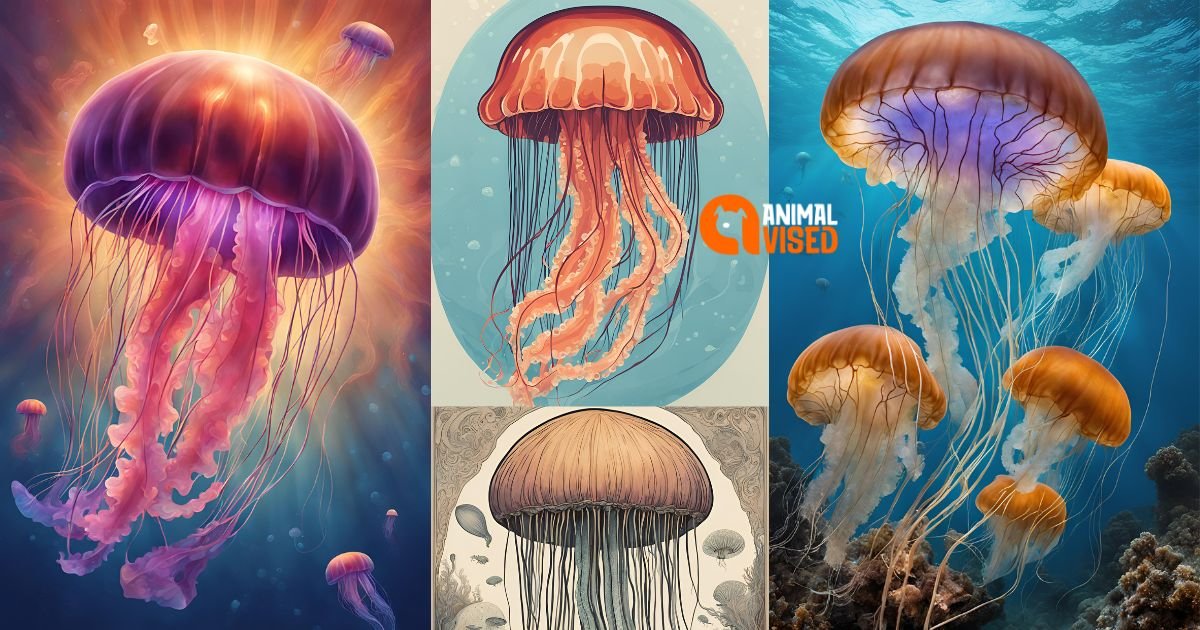Every year on November 3rd, we celebrate World Jellyfish Day 2024, a day set aside to raise awareness about the fascinating world of jellyfish. This day has a vital purpose in helping us understand the role these ancient creatures play within marine ecosystems. Jellyfish have existed for over 500 million years, even before the dinosaurs. They have evolved without brains, hearts, bones, or eyes, relying instead on a complex, intelligent nature to survive and thrive in diverse environments.
Read More: 15 Cute Animals That Are Actually Deadly
Jellyfish have unique roles in the ocean. Acting as both predators and prey, they help keep the marine ecosystem in balance. Their bioluminescence has even proven valuable for scientific research, allowing researchers to explore various ecological aspects of marine life. Despite lacking central brains or bones, they interact with other species, playing a crucial part in the marine food web. For instance, they are a primary food source for sea turtles and other species, helping sustain the ocean’s biodiversity.
In Pakistan, there’s a growing industry around jellyfish, especially in coastal regions like Sindh and Kalamat in Balochistan. Local fishermen have been harvesting jellyfish since 2003, an activity that has become essential to their livelihoods. Annual exports of jellyfish from Pakistan have reached 3,000 tons, with countries like China being primary importers. These jellyfish are prepared for export by salting and drying them, following sustainable practices that aim to protect marine ecosystems.
Climate change has also impacted jellyfish populations globally. With the decline of fish species that usually feed on jellyfish, their numbers have soared in many areas. This rise has drawn attention to their ecological significance and has led experts, like Muhammad Moazzam Khan, a Technical Adviser for the World Bank in Pakistan, to advocate for their sustainable management. Khan emphasizes the importance of recognizing jellyfish’s contribution to ocean health and the need for conservation.
Interestingly, jellyfish are not true fish; they belong to the Cnidaria phylum under the scientific class Scyphozoa, which includes coral and sea anemones. Over 200 species of jellyfish inhabit the world’s five oceans, adding unique diversity to marine ecosystems. Their anatomy is quite simple—they lack gills, spines, and blood, making them one of the oldest multi-organ animals on Earth. They drift through oceans, sometimes floating near the surface and sometimes moving to the deep.
One of the most fascinating aspects of jellyfish is their life cycle, which starts as larvae that drift in the open ocean before attaching to solid surfaces, eventually growing into adult jellyfish. Their umbrella-shaped bodies and tentacles make them easily recognizable and captivating to watch, but many species are also toxic, so experts warn against direct contact with them in the wild. However, there have been no fatal incidents from jellyfish stings recorded in Pakistan, allowing people to marvel at their beauty while maintaining caution.
Celebrating World Jellyfish Day serves as a reminder of these creatures’ ecological significance and the need for continued conservation efforts. From education about their role to understanding their potential for medical research, this day encourages us to value jellyfish not just as creatures but as an essential part of our ocean’s health. For those interested, participating in sustainable practices and supporting jellyfish research initiatives can contribute to protecting these incredible marine species.
Purpose of World Jellyfish Day 2024

World Jellyfish Day highlights the ecological importance of jellyfish and their essential role in maintaining the balance of marine food webs. These ancient creatures act as both predators and prey in the ocean ecosystem. By feeding on plankton, they help control plankton populations, while larger species like sea turtles and fish rely on them as a primary food source.
Scientists and conservationists also see jellyfish as significant subjects in medical research, especially in studies involving bioluminescent proteins and the potential applications in medicine. Climate change and habitat loss threaten these species, which makes this day crucial for promoting awareness and encouraging sustainable conservation practices. In some cultures, jellyfish are even seen as delicacies or valued for medicinal purposes, showing their importance beyond just their ecological functions.
History of World Jellyfish Day 2024

The origins of World Jellyfish Day are likely informal, thought to stem from enthusiastic marine biologists or groups who hold deep respect for these strange, beautiful creatures. The largest populations are found in the southern hemisphere, particularly in Australia and South Africa, where beaches become teeming with interesting yet dangerous jellyfish during springtime.
Since 2014, November 3rd has been marked as World Jellyfish Day, with migration bringing jellyfish closer to northern hemisphere shores this time of year. The day has become globally recognized as a time to highlight and celebrate these brainless beauties that have been floating through our oceans for millions of years. Acknowledged as a day for education and conservation, it urges people to support efforts to protect marine ecosystems and sea jellies facing challenges in their habitats.
Some say that November 3 honors Dr. Ernst Haeckel, a renowned German biologist known for his pioneering research on jellyfish and other marine life. Today, institutions like NOAA’s Office of Ocean Exploration celebrate World Jellyfish Day by sharing remarkable footage from expeditions, showing diverse species in midwater zones across the ocean, which raises further awareness about their role in the world’s ecosystems.
Significance of World Jellyfish Day

World Jellyfish Day shines a light on the incredible role that jellyfish play in marine ecosystems. Far from being mere pests or nuisances, jellyfish are essential members of the marine community, impacting the biomass, spatiotemporal dynamics, and structure of global plankton networks. These creatures help support marine life by consuming plankton, tiny organisms that make up the base of the food chain, providing a foundation for various other species. They fill multiple positions within marine food webs, both as predators and prey—from feeding on smaller organisms to becoming a source of nourishment for larger animals like fish and sea turtles. This balance they create is crucial for the stability and health of ecosystems worldwide.
The significance of World Jellyfish Day goes beyond ecology. For humans, jellyfish offer numerous benefits: their unique proteins, especially the green fluorescent protein (GFP), are invaluable in medical research and biotechnology. This protein, which causes their bioluminescence, has opened doors for many medical applications. Jellyfish are also considered a potential sustainable food source due to their abundance and nutritional value, offering an alternative that could help address food security in a growing global population. Their tissues and toxins are continually being studied, showing promise in various fields.
World Jellyfish Day serves as an event to raise awareness about the environmental challenges these creatures face, including habitat loss and pollution, which threaten their populations and the ecosystems they support. It is a chance to educate the public on the threats that jellyfish encounter, while also celebrating their beauty and diversity. Observing this day helps us better appreciate their ecological importance and recognize the pressing need to protect them for the stability of marine ecosystems worldwide.
Interesting Facts about Jellyfish

Fascinating World Jellyfish Day: 10 Facts
Jellyfish are amazing creatures that are made up of 95% water and do not have bones, hearts, or even a brain. Instead, they have a central nervous system that allows them to interact with their surroundings. These incredible animals have been around for 500 million years, making them older than dinosaurs! Some jellyfish can even glow in the dark thanks to their bioluminescent organs, which can emit blue or green light when they are stimulated or touched.
A group of jellyfish is known as a bloom, swarm, or smack, which are fun ways to describe a collection of these unusual and fascinating creatures. One of the most notable species is the Hair Jelly, which is enormous. The largest one ever discovered washed up in Massachusetts, USA, in 1870, and had tentacles longer than a blue whale, measuring over 120 feet! These jellyfish use their tentacles to catch food like fish, shrimp, and tiny plants, which they can digest quickly.
In Chinese culture, jellyfish are considered a delicacy and are used in traditional treatments. However, they can also cause pain to humans with their stings, and in some cases, certain species can be dangerous enough to cause death. Despite this, jellyfish are interesting because they have unique abilities. For instance, some species can even biologically reverse their aging process and live for up to two years, like the lion’s mane jellyfish.
Jellyfish have six main body parts, including the epidermis, gastrodermis, mesoglea, gastrovascular cavity, mouth, and tentacles. They are omnivores, meaning they eat a variety of food. They have a single opening that serves as their mouth, used for eating, expelling waste, and propelling themselves by releasing water. At the London Aquarium, experts have even created a breeding facility for barrel jellyfish, starting from their earliest stages as polyps. It’s important to pay heed to jellyfish and learn more about their life and role in our oceans.
World Jellyfish Day is celebrated on November 3rd each year to raise awareness of jellyfish and their significant ecological role in marine ecosystems. These ancient creatures, existing for over 500 million years, have evolved without brains, hearts, or bones, relying on a central nervous system for survival. Jellyfish are crucial as both predators and prey, helping maintain the balance of marine food webs. They contribute to biodiversity by serving as a food source for species like sea turtles. In Pakistan, the jellyfish industry has grown, providing livelihoods for local fishermen and leading to substantial exports. However, climate change poses a threat to jellyfish populations, making conservation efforts vital. Additionally, jellyfish are subjects of medical research, particularly due to the unique proteins they possess, such as green fluorescent protein (GFP).
Conclusion
World Jellyfish Day emphasizes the ecological importance of jellyfish and the need for continued conservation efforts. As both fascinating and essential members of marine ecosystems, jellyfish should be celebrated for their beauty and diversity while recognizing the challenges they face. Through education and sustainable practices, we can help protect these remarkable creatures and the health of our oceans.
10 FAQs About Jellyfish
Q: What are jellyfish made of?
A: Jellyfish are composed of about 95% water and lack bones, hearts, or brains.
Q: How long have jellyfish existed?
A: Jellyfish have been around for more than 500 million years, predating dinosaurs.
Q: Do jellyfish have a brain?
A: No, jellyfish do not have a brain; they possess a central nervous system that allows them to react to their environment.
Q: What is bioluminescence in jellyfish?
A: Bioluminescence is the ability of jellyfish to glow in the dark using special bioluminescent organs that emit blue or green light.
Q: What do jellyfish eat?
A: Jellyfish primarily feed on plankton, fish, and tiny organisms using their tentacles to catch prey.
Q: Are jellyfish dangerous to humans?
A: Some jellyfish species can sting and cause pain, but there have been no recorded fatal incidents from jellyfish stings in Pakistan.
Q: What is the largest jellyfish species?
A: The Hair Jelly is the largest species, with a record length of over 120 feet, including its tentacles.
Q: How do jellyfish reproduce?
A: Jellyfish have a unique life cycle starting as larvae that attach to solid surfaces and grow into adult jellyfish.
Q: Why are jellyfish important to marine ecosystems?
A: Jellyfish play a crucial role in maintaining the balance of marine food webs by acting as both predators and prey.
Q: How are jellyfish used in medicine?
A: Jellyfish proteins, like green fluorescent protein (GFP), are used in medical research and biotechnology for various applications.










